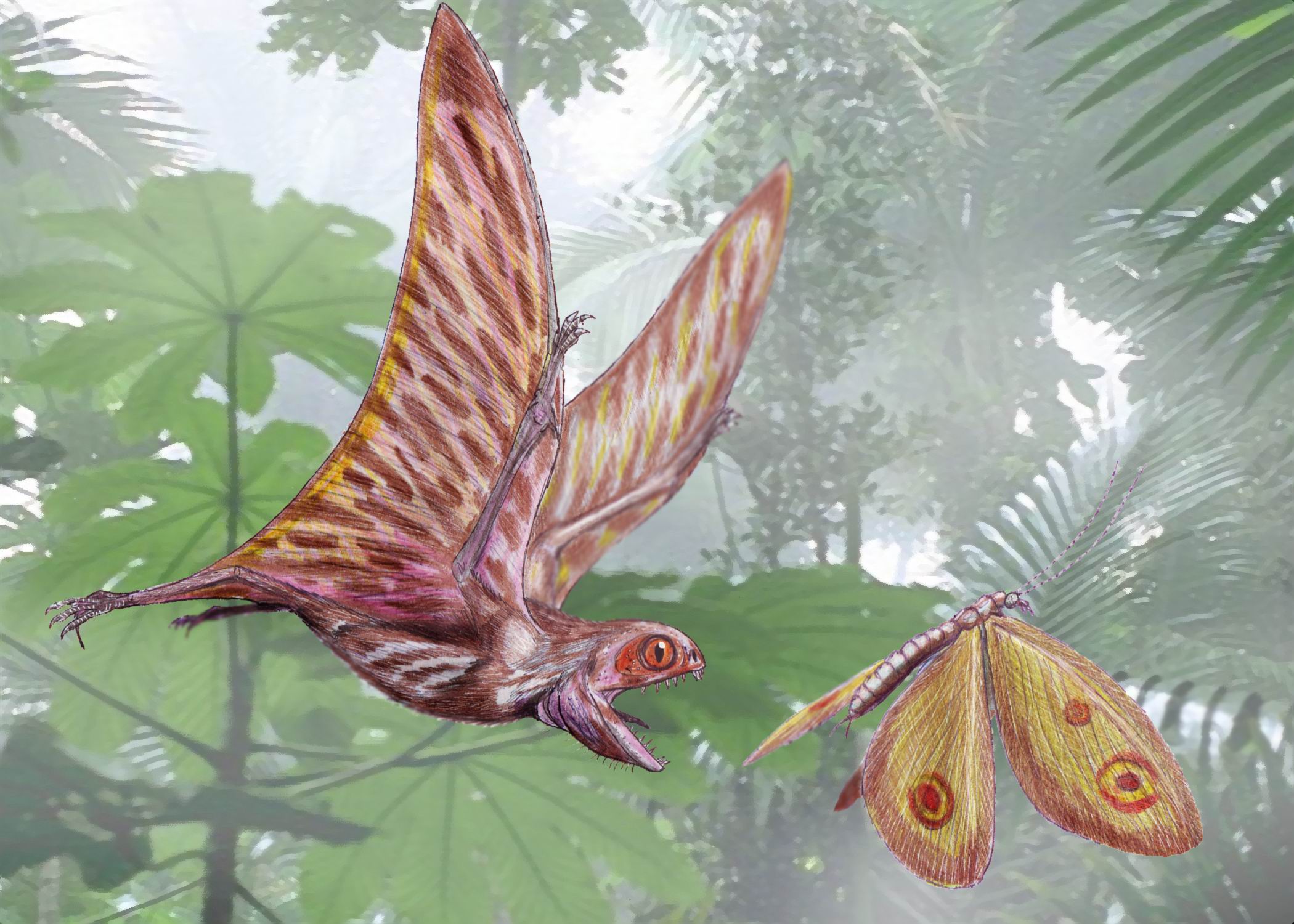The "new non-fiction" rack at the library had Mark P. Witton's book, Pterosaurs, and I began reading it, partly because it was there, and also because I wanted to know what we know about these long-extinct flying reptiles, and how we know it.
Pterosaurs arose in the Triassic, survived the Triassic-Jurassic mass extinction event, and flourished all the way to the end of Cretaceous, when they too met their end. An impressive run, from approximately 240 million years ago to 66 million years ago! There were a great variety of pterosaurs during this time, ranging in size from small birds to as tall as a giraffe. Wiki has a good overview.
Witton's book is encyclopedic, but he manages to make a dry subject quite readable. (When the book goes to its second edition, a glossary would be a welcome addition.)
Here is a representative paragraph, minus the citations.
Here is what a specimen of Anurognathus might have looked like (from Wiki), shown here chasing a dragonfly-like insect. (Witton has his own set of delightful illustrations, you can catch a glimpse of them at the amazon.com link in the first line of this post.)
FYI, Witton on pycnofibers:
Pterosaurs arose in the Triassic, survived the Triassic-Jurassic mass extinction event, and flourished all the way to the end of Cretaceous, when they too met their end. An impressive run, from approximately 240 million years ago to 66 million years ago! There were a great variety of pterosaurs during this time, ranging in size from small birds to as tall as a giraffe. Wiki has a good overview.
Witton's book is encyclopedic, but he manages to make a dry subject quite readable. (When the book goes to its second edition, a glossary would be a welcome addition.)
Here is a representative paragraph, minus the citations.
Several anurognathid fossils provide a good insight into how fuzzy pterosaurs were. The pycnofibers of Jeholopterus are preserved in a shapeless mat similar to those left by the hair of many fossil mammals, suggesting they were covered, from nose to elbows and knees, in dense pelts comparable to those we see in hairy mammals. The manner in which their pycnofibers cover their snouts and jaws seems to be unique among pterosaurs (presumably because most pterosaurs thought it just wasn't cool to look like the Cookie Monster from Sesame Street). The slightly rugose bone texture around the jaws of Anurognathus has been suggested to mark where a series of thick bristles once anchored, but I'm not too sure about this interpretation. Hairs or feathers rarely leave such obvious marks on their owners' skulls and, moreover, no anurognathid fossil has shown these features yet despite excellent preservation of their facial pycnofibers. What is know for certain, however, is that some anurognathids bore a short tuft of short pycnofibers on the trailing edges of their wing tips, a feature unrecorded from any other pterosaur.As to how we know what we know, the most important component are the fossils, some of which even have traces of soft tissues of the animal preserved in the rocky matrix, visible under ultraviolet light. There are eggs, and regurgitated food, and footprints, and the equivalent of beak marks made by pecking birds, preserved in the fossil record. To interpret all this material, however, requires a lot of comparative anatomy, of currently extant species and of extinct ones, and the theory of evolution to arrange them in family trees and to provide a framework for explanations. I can't do justice to all the different lines of reasoning that are brought to bear on trying to understand all of this.
Here is what a specimen of Anurognathus might have looked like (from Wiki), shown here chasing a dragonfly-like insect. (Witton has his own set of delightful illustrations, you can catch a glimpse of them at the amazon.com link in the first line of this post.)
FYI, Witton on pycnofibers:
Pterosaur bodies were adorned with pycnofibers, the recently coined name for pterosaur fuzz. A hairlike integument was first reported for pterosaurs in 1831, and again in 1927, and despite some periodic controversies and resistance to the idea, it is now universally accepted that most or all pterosaurs were covered in some kind of pelage. Pycnofibers seem to have been fairly short (only 5-7 mm in some specimens), tapering, and flexible structures apparently lacking in any internal detail aside from a central canal. They also may not have been anchored deeply into the skin, unlike the hair of mammals. Opinions differ over exactly how dense pterosaur pelts were. Unwin (2005) suggested that their fibers were no more concentrated than the hairs on a human arm, but others have compared the heaviness of their coats to those of furry mammals. The latter interpretation may be more accurate. Pterosaur pelts appear to be preserved in concentrated, dense mats of fibers similar to those surrounding fossil mammals, suggesting they were just as fuzzy as our fossil ancestors........
